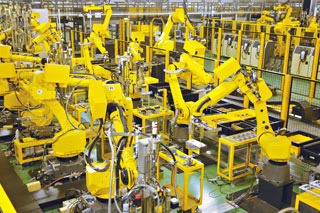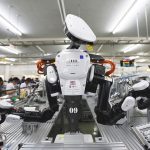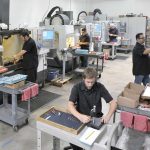While most Americans still grapple with the idea that millions of jobs will soon be taken by robots and automation, Bill Gates is thinking ahead.
The Microsoft co-founder believes that government should develop a system that taxes each robot put into place on a factory floor or in a warehouse.
“Right now, the human worker who does, say, $50,000 worth of work in a factory, that income is taxed and you get income tax, social security tax, all those things. If a robot comes in to do the same thing, you’d think that we’d tax the robot at a similar level,” he said.

In an interview with Quartz, Gates said if the business world wants to replace human labor with machines, there should be some repercussions and a revenue source to ease the transition toward a monumental change in the workplace.
Gates flips conventional thinking on its head. Retraining manufacturing workers to handle increasingly high-tech jobs is a temporary fix because eventually robotics and supercomputers will outperform humans in a wide array of tasks. Gates believes that future robot-tax dollars generated should finance training for workers displaced by robots and automation for hands-on jobs in social services, healthcare and education.
What the (business) world wants is to take this opportunity to make (through automation) all the goods and services we have today, and free up labor. Let us do a better job of reaching out to the elderly, having smaller (K-12) class sizes, helping kids with special needs. You know, all of those are things where human empathy and understanding are still very, very unique. And we still deal with an immense shortage of people to help out there.
So, if you can take the labor that used to do the thing automation replaces, and financially and training-wise and fulfillment-wise, have that person go off and do these other things, then you’re net-ahead. But you can’t just give up that income tax, because that’s part of how you’ve been funding that level of human workers.
Maybe. But Gates is several steps ahead of most Americans. Many workers don’t think they need to adapt to the coming technological revolution. Some 80% said their job definitely or probably will exist in its current form in 50 years, according to the Pew Research Center.
In addition, numerous news reports have indicated that displaced blue-collar workers often shun the conventional approach of receiving training to work with computers; they want a traditional job as a craftsman where they “work with their hands.”
USA Today recently reported that, as artificial-intelligence computer programs proliferate, automation won’t be confined to the factory floor. Office positions that involve a substantial amount of repetitive, rote work, such as data processing, could succumb to automated software.
A largely overlooked study released in January found that half of all activities conducted on the job by employees in the U.S. could be performed using automation that relies on current technology.
The McKinsey Global Institute found that the industries most likely to make the switch to machines are manufacturing, food service and retail, but the potential for automation is also abundant in the office setting, representing a significant threat to white-collar workers and professionals.
McKinsey counted more than 70 entire professions in which at least 90% of activities can be automated, ranging from mail clerks to lab technicians, tire-repairers, butchers, food preparers and bakers.
“We often think about automation as applying to front-line, low-wage, low-skill activities and jobs — and what we’ve discovered is there are some activities that are high-wage, high-skill that are actually very susceptible to automation,” Michael Chui, a McKinsey partner in San Francisco, told USA Today. “Almost every job in the economy has a significant percentage of activities that can be automated.”
Not surprisingly, the robot manufacturing industry expects to sell a third more units from 2016 through 2019 — 333,200 in all — than it sold in the past 17 years combined, according to the International Federation of Robotics.
Other futurists in the private sector see specialized robots and robotic arms playing a key role in the workplace side-by-side with human workers who would serve as supervisors of the machines. Some expert analysts say annual sales of these collaborative robots, or “co-bots,” will skyrocket from approximately 4,000 in 2015 to roughly 700,000 in 2025.
All forms of automation could be used beyond the blue-collar world to places of professionals, whether it’s medicine, agriculture, hospitality or even supermarkets:
- A San Francisco firm has developed a hamburger-flipping robot.
- Lowes is experimenting with robotics to keep its shelves stocked.
- Walmart announced plans in September to cut 7,000 bookkeeping and store accounting positions as it automates cash management and centralizes the process at its headquarters.
- In the beleaguered mining industry, a self-driving, autonomous truck the size of a house has replaced traditional mine workers in hauling coal and other materials.
Within the auto industry, the move toward automation and robotics is nothing new. Automakers for decades have wholeheartedly embraced technology and robotic technicians as a replacement for assembly line brawn.
At its height, the Ford Rouge Complex in Wayne County employed more than 100,000 workers. Today, its payroll amounts to about 6,000 people because much of the work is done by robots, according to the Michigan Future Inc. research group in Ann Arbor. Because of automation, General Motors’ assembly plants in metro Lansing now employ fewer than 6,000 hourly workers, down from the 23,000 who built cars in the region as recently as 1979.
Across the nation, many small manufacturing firms have found that they can greatly improve productivity by investing in automation, even if that means keeping the core of their (human) workforce. The workers who stay are those with the most education and those who have upped their technology skills through training programs.
Nonetheless, employers of every stripe typically cite the same reasons for switching to fully automated production: machines have higher output and greater precision, plus they don’t receive a salary or benefits, a vacation, a sick day or even a bathroom break.
Under the Gates’ plan, taxes would somewhat level that playing field.
Photo: Michigan Future Inc./Shutterstock









